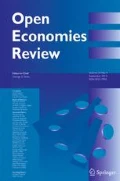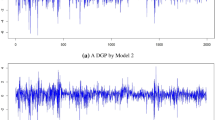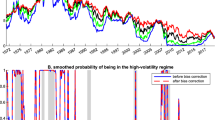Abstract
This study investigates whether the ignored structural break causes the forward premium non-stationary. This paper proposes to test for the presence of unit root with multiple structural breaks. We find that, as long as the dynamic lag structure is specified, the forward premium exhibits a non-stationary process even if structural breaks are accounted for and points to no evidence of moving toward stationarity. Given our findings, the structural change model seems less robust in explaining the forward premium puzzle.


Similar content being viewed by others
Notes
As can be seen in Table 2.
As seen in the Panel A of Table 8 where the lag order is selected by the MBIC, serial correlation still exists in the forward premium of Japanese yen and British pound. In order to further robustify our empirical evidence, this study also chooses the lag length by using the BIC criterion, with a preset of plausible maximum lag structure as 3. We then perform serial correlation testing to see if there is any remaining serial correlation with the optimal lag order chosen. If there is, we increase the lag order by one sequentially until serially uncorrelated residual vectors are obtained. The results based on such procedure are presented in the Panel B of Table 7, Panel B of Table 8, and Panels E though H of Table 10. Hereafter we name the above mentioned strategy as “the strategy based on the BIC.”
For the purpose to strengthen our argument, given that Sakoulis et al. (2010) used the U.S. dollar as the reference currency, this study re-evaluates their work by using monthly mid-rate of spot and forward series of the same currencies during the same sample period. Results will be available upon request.
Zivot and Andrews (1992)’s unit root tests on the forward premiums of our sample are provided in Table 12. Their test for allowing a structural break in level has the following form:
y t = a j + φ 1 y t − 1 + δ 1 trend + ∑ p i = 1 γ 1i Δy t − i + ε 1t , for t = T j−1 + 1,…,T j , where trend stands for a time trend. The other test regression for taking into account a breakpoint in both level and slope is as follows:
\( {y}_t={a}_j+{\varphi}_2{y}_{t-1}+{\delta}_2 trend+{\chi}_{1j}{r}_{{}_{j,t-1}}+{\displaystyle {\sum}_{i=1}^p{\gamma}_{2i}\varDelta {y}_{t-i}+{\varepsilon}_{2t}}, \) for t = T j−1 + 1,…,T j , where r j,t−1 is the lagged variable where a structural change exists. Both forms are used to evaluate the unit root null hypothesis of φ 1 = 1 (φ 2 = 1) against the alternative hypothesis of φ 1 < 1 (φ 2 < 1).
Elliott et al. (1996) argue, however, the standard DF unit root test only works when the series is an AR(1) process. In the case where the series is correlated at higher-order lags, the standard test may not be valid, because it violates the assumption of white noise (Diebold and Rudebusch 1991). The problem can be taken care of under the ADF unit root test; for it is a fact that the test carries a parametric correction for a higher-order correlation by assuming that the series follows an AR(p) process and by adding lagged difference terms of the dependent variable to the right-hand side of the test regression.
We also plot the ACF of residuals for the six Euro forward premiums obtained from the AR(1) multiple structural break model. In consistent with the Ljung-Box statistics results, the ACF figures show that the autocorrelation at most lags is significant at the 5 % statistical significance, and thus residuals appear to be serially correlated. Results are available upon request.
Table 6 presents estimates on the forward premium regression in AR(1) with a lag structure as follows: \( {y}_t=\tilde{a}+\tilde{b}{y}_{t-1}+{\displaystyle \sum_{i=1}^p{\tilde{\phi}}_i\varDelta {y}_{t-i}}+{\tilde{\upsilon}}_t. \)
This study plots the autocorrelation of residuals for the six forward premiums, which are modelled as an AR(1) with a lag structure incorporated with multiple structural breaks. Based on the figure results, we reach the same conclusion with the Ljung-Box statistics results. The ACF results will be available upon request.
References
Al-Khazali OM, Pyun CS, Kim D (2012) Are exchange rate movements predictable in Asia-Pacific markets? Evidence of random walk and martingale difference processes. Int Rev Econ Financ 21(1):221–231
Backus D, Gregory A, Telmer C (1993) Accounting for forward rates in markets for foreign currency. J Financ 48:1887–1908
Bai J, Perron P (1998) Estimating and testing linear models with multiple structural changes. Econometrica 66:47–78
Bai J, Perron P (2003) Computation and analysis of multiple structural change models. J Appl Econ 18(1):1–22
Baillie RT, Bollerslev T (1994) The long memory of the forward premium. J Int Money Financ 13(5):565–571
Baillie RT, Bollerslev T (2000) The forward premium anomaly is not as bad as you think. J Int Money Financ 19:471–488
Barkoulas J, Baum CF, Chakraborty A (2003) Forward premiums and market efficiency: panel unit-root evidence from the term structure of forward premiums. J Macroecon 25(1):109–122
Canzoneri M, Cumby R, Diba B (2013) Addressing international empirical puzzles: the liquidity of bonds. Open Econ Rev 24(2):197–215
Chen YC, Yu WC (2011) Structural change in the forward discount: a Bayesian analysis of forward rate unbiasedness hypothesis. Econ Bull 31(2):1807–1826
Choi K, Zivot E (2007) Long memory and structural breaks in the forward discount: an empirical investigation. J Int Money Financ 26:342–363
Chu KH (2005) Solution to the Siegel paradox. Open Econ Rev 16(4):399–405
Ciner C (2011) Eurocurrency interest rate linkages: a frequency domain analysis. Int Rev Econ Financ 20:498–505
Coakley J, Dollery J, Kellard N (2011) Long memory and structural breaks in commodity futures markets. J Futur Mark 31(11):1076–1113
DeJong DN, Nankervis JC, Savin NE, Whiteman CH (1992) The power problems of unit root test in time series with autoregressive errors. J Econ 53(1):323–343
Delcoure N, Barkoulas J, Baum CF, Chakraborty A (2003) The forward rate unbiasedness hypothesis reexamined: evidence from a new test. Glob Financ J 14(1):83–93
Diebold FX, Rudebusch GD (1991) On the power of Dickey-Fuller tests against fractional alternatives. Econ Lett 35(2):155–160
Elliott G, Rothenberg TJ, Stock JH (1996) Efficient tests for an autoregressive unit root. Econometrica 64(4):813–836
Engle RF, Granger CW (1987) Cointegration and error correction: representation, estimation, and testing. Econometrica 55:251–276
Evans MD, Lewis KK (1995) Do expected shifts in inflation affect estimates of the long-run fisher relation? J Financ 50(1):225–253
Fama E (1984) Forward and spot exchange rates. J Monet Econ 14:319–338
Frankel JA, Froot KA (1988) Explaining the demand for dollars: international rates of return and the expectations of chartists and fundamentalists. In: Chambers R, Paarlberg P (eds) Agriculture, macroeconomics and the exchange rate. Westview Press, Boulder
Froot KA, Thaler RH (1990) Anomalies: foreign exchange. J Econ Perspect 4:179–192
Granger CWJ, Hyung N (2004) Occasional structural breaks and long memory with an application to the S&P 500 absolute stock returns. J Empir Financ 11:399–421
Granger CW, Newbold P (1974) Spurious regressions in econometrics. J Econ 2(2):111–120
Hall SG, Kenjegaliev A, Swamy PAVB, Tavlas GS (2013) The forward rate premium puzzle: a case of misspecification? Stud Nonlinear Dyn Econ 17(3):265–279
Hodrick RJ (1987) The Empirical Evidence on the Efficiency of Forward and Futures Foreign Exchange Markets. London, Harwood Academic Publishers
Hodrick R, Srivastava S (1986) The covariation of risk premiums and expected future spot rates. J Int Money Financ 3:5–30
Kellard N, Sarantis N (2008) Can exchange rate volatility explain persistence in the forward premium? J Empir Financ 17:714–728
Kutan AM, Zhou S (2003) Has the link between the spot and forward exchange rates broken down? Evidence from rolling cointegration tests. Open Econ Rev 14(4):369–379
Lee J, Strazicich MC (2001) Break point estimation and spurious rejections with endogenous unit root tests. Oxf Bull Econ Stat 63(5):535–558
Lewis KK (1989) Changing beliefs and systematic rational forecast errors with evidence from foreign exchange. Am Econ Rev 79(4):621–636
Lopez JH (1997) The power of the ADF test. Econ Lett 57:5–10
Mark N (1985) On time varying risk premia in the foreign exchange market: an econometric analysis. J Monet Econ 16:3–18
Maynard A, Phillips PCB (2001) Rethinking an old empirical puzzle: econometric evidence on the forward discount anomaly. J Appl Econ 16:671–708
McCallum BT (1994) A reconsideration of the uncovered interest parity relationship. J Monet Econ 33:105–132
Ng S, Perron P (1995) Unit root tests in ARMA models with data dependent methods for the selection of the truncation lag. J Am Stat Assoc 90:268–281
Ng S, Perron P (2001) Lag length selection and the construction of unit root tests with good size and power. Econometrica 69(6):1519–1554
Perron P, Ng S (1996) Useful modifications to unit root tests with dependent errors and their local asymptotic properties. Rev Econ Stud 63:435–465
Perron P, Qu Z (2007) A simple modification to improve the finite sample properties of Ng and Perron’s unit root tests. Econ Lett 94(1):12–19
Sakoulis G, Zivot E, Choi K (2010) Structural change in the forward discount: Implications for the forward rate unbiasedness hypothesis. J Empir Financ 17:957–966
Schwert GW (1989) Tests for unit roots: a Monte Carlo investigation. J Bus Econ Stat 7(2):147–159
Taylor MP (1995) The economics of exchange rates. J Econ Lit 33:13–47
Zivot E, Andrews DW (1992) Further evidence on the great crash, the oil-price shock, and the unit-root hypothesis. J Bus Econ Stat 10(3):251–270
Acknowledgments
The authors gratefully acknowledge specific comments by anonymous referees to improve the paper. All errors are the sole responsibility of the authors.
Author information
Authors and Affiliations
Corresponding author
Appendix 1
Appendix 1
Rights and permissions
About this article
Cite this article
Ho, TW., Mo, WS. Testing the Persistence of the Forward Premium: Structural Changes or Misspecification?. Open Econ Rev 27, 119–138 (2016). https://doi.org/10.1007/s11079-015-9365-9
Published:
Issue Date:
DOI: https://doi.org/10.1007/s11079-015-9365-9
Keywords
- Forward premium puzzle
- Unit roots with structural changes
- Predictability
- Forward rate unbiasedness hypothesis
- Persistence




